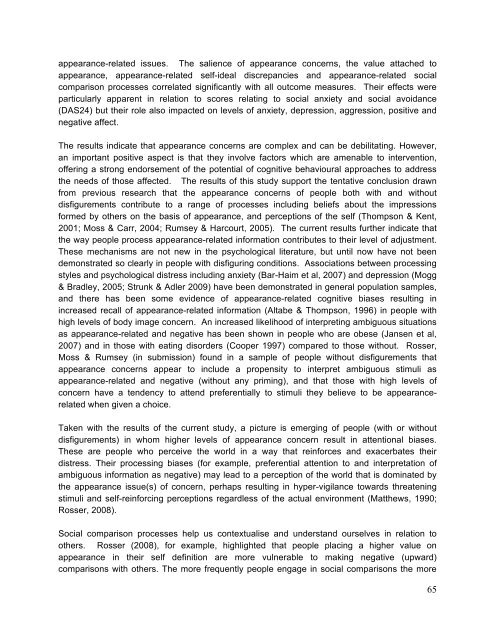Download the report - The Healing Foundation
Download the report - The Healing Foundation
Download the report - The Healing Foundation
Create successful ePaper yourself
Turn your PDF publications into a flip-book with our unique Google optimized e-Paper software.
appearance-related issues. <strong>The</strong> salience of appearance concerns, <strong>the</strong> value attached to<br />
appearance, appearance-related self-ideal discrepancies and appearance-related social<br />
comparison processes correlated significantly with all outcome measures. <strong>The</strong>ir effects were<br />
particularly apparent in relation to scores relating to social anxiety and social avoidance<br />
(DAS24) but <strong>the</strong>ir role also impacted on levels of anxiety, depression, aggression, positive and<br />
negative affect.<br />
<strong>The</strong> results indicate that appearance concerns are complex and can be debilitating. However,<br />
an important positive aspect is that <strong>the</strong>y involve factors which are amenable to intervention,<br />
offering a strong endorsement of <strong>the</strong> potential of cognitive behavioural approaches to address<br />
<strong>the</strong> needs of those affected. <strong>The</strong> results of this study support <strong>the</strong> tentative conclusion drawn<br />
from previous research that <strong>the</strong> appearance concerns of people both with and without<br />
disfigurements contribute to a range of processes including beliefs about <strong>the</strong> impressions<br />
formed by o<strong>the</strong>rs on <strong>the</strong> basis of appearance, and perceptions of <strong>the</strong> self (Thompson & Kent,<br />
2001; Moss & Carr, 2004; Rumsey & Harcourt, 2005). <strong>The</strong> current results fur<strong>the</strong>r indicate that<br />
<strong>the</strong> way people process appearance-related information contributes to <strong>the</strong>ir level of adjustment.<br />
<strong>The</strong>se mechanisms are not new in <strong>the</strong> psychological literature, but until now have not been<br />
demonstrated so clearly in people with disfiguring conditions. Associations between processing<br />
styles and psychological distress including anxiety (Bar-Haim et al, 2007) and depression (Mogg<br />
& Bradley, 2005; Strunk & Adler 2009) have been demonstrated in general population samples,<br />
and <strong>the</strong>re has been some evidence of appearance-related cognitive biases resulting in<br />
increased recall of appearance-related information (Altabe & Thompson, 1996) in people with<br />
high levels of body image concern. An increased likelihood of interpreting ambiguous situations<br />
as appearance-related and negative has been shown in people who are obese (Jansen et al,<br />
2007) and in those with eating disorders (Cooper 1997) compared to those without. Rosser,<br />
Moss & Rumsey (in submission) found in a sample of people without disfigurements that<br />
appearance concerns appear to include a propensity to interpret ambiguous stimuli as<br />
appearance-related and negative (without any priming), and that those with high levels of<br />
concern have a tendency to attend preferentially to stimuli <strong>the</strong>y believe to be appearancerelated<br />
when given a choice.<br />
Taken with <strong>the</strong> results of <strong>the</strong> current study, a picture is emerging of people (with or without<br />
disfigurements) in whom higher levels of appearance concern result in attentional biases.<br />
<strong>The</strong>se are people who perceive <strong>the</strong> world in a way that reinforces and exacerbates <strong>the</strong>ir<br />
distress. <strong>The</strong>ir processing biases (for example, preferential attention to and interpretation of<br />
ambiguous information as negative) may lead to a perception of <strong>the</strong> world that is dominated by<br />
<strong>the</strong> appearance issue(s) of concern, perhaps resulting in hyper-vigilance towards threatening<br />
stimuli and self-reinforcing perceptions regardless of <strong>the</strong> actual environment (Mat<strong>the</strong>ws, 1990;<br />
Rosser, 2008).<br />
Social comparison processes help us contextualise and understand ourselves in relation to<br />
o<strong>the</strong>rs. Rosser (2008), for example, highlighted that people placing a higher value on<br />
appearance in <strong>the</strong>ir self definition are more vulnerable to making negative (upward)<br />
comparisons with o<strong>the</strong>rs. <strong>The</strong> more frequently people engage in social comparisons <strong>the</strong> more<br />
65


